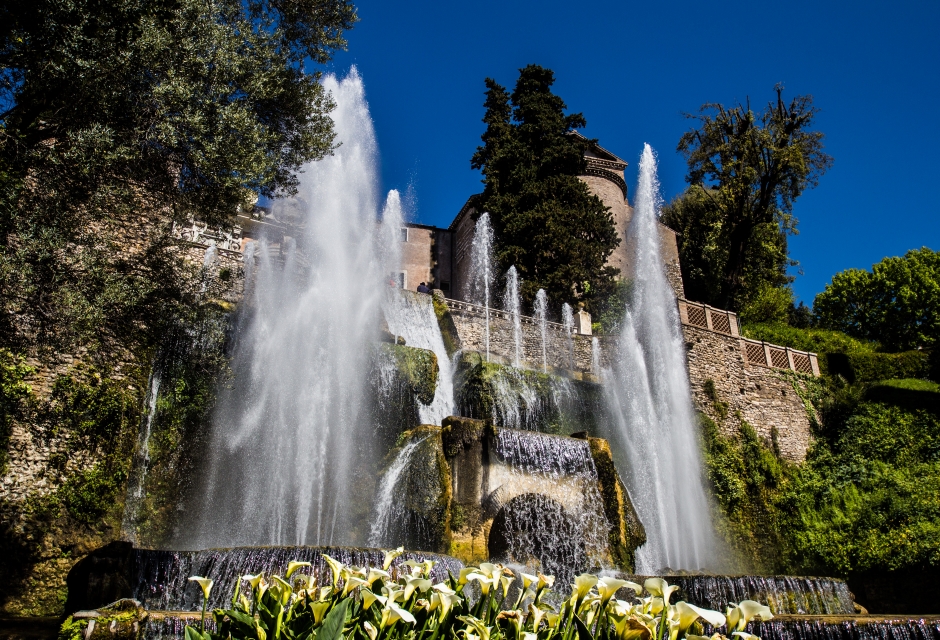Villa d’Este
A prime example of opulence in the Italian Rennaissance
Country: Italy | Type: Cultural | Theme: Garden, Residence, Secular Structure
Introduction to Villa d’Este, Tivoli
To the east of Rome in the hilltop village of Tivoli, the palace and gardens of the Villa dEste are one of the most comprehensive examples of opulent living in the Italain Rennaissance period. In particular, the gardens of the villa are considered to be the most striking examples of European garden design, with innovative designs in water features, architectural objects, and grottos. In 1550, the palace was converted from a Benedictine monastery, to become a retreat for wealthy Roman families. The gardens complimented the villas rich interiors, and the cooling water gave a rest bite from the fierce summer heat.
The villa’s design is irregular and built in different styles to accommodate the early monastical buildings and recent additions. The garden facing façade is simple, built over three floors, long and flat, with rows of tall windows, and an elegant loggia as its centrepiece. The main rooms of the villa, which open out into the gardens, are arranged on this side over two floors; the private apartments of the cardinal are on the same level as the courtyard, linked by a long corridor.
The gardens of the Villa d’Este are designed over two steep slopes leading down to a flat terrace, giving the appearance of an amphitheatre. The formal gardens are designed around five axes, the centre being a fixed viewpoint from the villa, and each axis ending in an important fountain. The central axis, known as the Peschiere, is where the avenue of One Hundred Founatins gives way to a series of diagonal pathways, and to the east, is the Fontana Dell’Organo, or the Organ Fountain. The fountain uses a combination of water and air to power the organ, which still plays every two hours.
Beyond the Path of the Dragons, the central staircase divides to create an oval shape around the Fontana dei Dragh. With its four winged dragons, the fountain spurs high jets of water, however, the gardens highlight is an incredible cascade that flows from a large Greek vase; the vase sits in the middle of a domed recess with jets of water being activated by unsuspecting visitors.
Two other fountains of note are the Fountain of Rome, and the Fountain of the Great Glass, designed by Bernini.
In September 1550, Cardinal Ippolito II d’Este was granted the governorship of the town of Tivoli. His official residence, a monastery and a church, did not suit his cultured background, so he set about building a magnificent villa on the steep slopes which surrounded it. Great pains were also taken over the gardens, and in 1560, an aqueduct, and an underground canal were constructed to supply sufficient water for the many fountains that had been installed; the flow of the water was made possible by natural gravity caused by the differing levels of the gardens. During this time, the monastery was also converted into a villa, but unfortunately, the cardinal died before it was completed.
The Cardinal’s nephew, Luigi d’Este inherited the estate, but he did not have the resources of his uncle and was unable to keep up with the building, or the maintenance. The estate was then passed through the d’Este family with an ongoing project of construction and restoration, but lack of funds and abandonment followed. The palace was finally taken by the Hapsburgs in 1830, and was saved before being handed over to the Italian government in 1920.
Villa d’Este is situated in the centre of Tivoli, 20 km/12.5 miles from Rome. It is closed on Mondays, except when Monday is an official holiday when it remains open, and closes the following day; it is also closed on January 1st, May 1st, and 25th December. The site is open from 8.30am and closes one hour before sunset, the hydraulic organ plays every two hours from 10.30am, and the Fontana della Civetta functions every two hours from 10.00am. Between July and September, the villa and gardens are also open on Friday and Saturday nights until midnight.
Getting there:
By car take the Tivoli exit from the A24 Autostrada, signposted Villa d’Este and Villa Adriana.
By train alight at Stazione Tivoli on the Roma-Pescara Line.
By bus from the Ponte Mammolo metro station take the Cotral Bus, Roma to Tivoli bus station.
Key Facts
Inscribed:2001
Nearest City:Rome
Province:Rome
Coordinates: Lat: 41.9639, Long: 12.7963
Accessibility:Easy
Services:Extensive
Highlights
- The Avenue of One Hundred Fountains
- The vista from the Organ Terrace over the fishponds
- The Owl’s Fountain
- The Dragons Fountain
- The brightly decorated Fountain’s Room
- The Organ Fountain, especially beautiful at dusk
Find a Tour
Like to visit? Fill out this form and reliable local hospitality companies will contact you to discuss your ideas.



